
Afonso I, also called Afonso Henriques, nicknamed the Conqueror and the Founder by the Portuguese, was the first king of Portugal. He achieved the independence of the County of Portugal, establishing a new kingdom and doubling its area with the Reconquista, an objective that he pursued until his death.
Year 1142 (MCXLII) was a common year starting on Thursday of the Julian calendar.
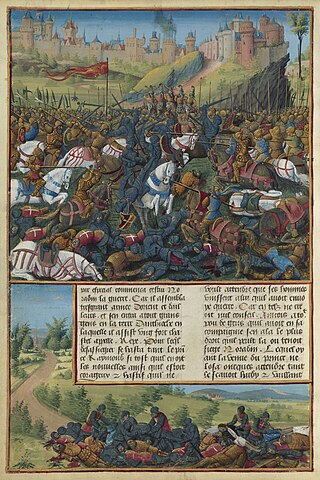
The Second Crusade (1147–1150) was the second major crusade launched from Europe. The Second Crusade was started in response to the fall of the County of Edessa in 1144 to the forces of Zengi. The county had been founded during the First Crusade (1096–1099) by King Baldwin I of Jerusalem in 1098. While it was the first Crusader state to be founded, it was also the first to fall.

The Siege of Lisbon, from 1 July to 25 October 1147, was the military action against the Muslim-ruled Taifa of Badajoz that brought the city of Lisbon under the definitive control of the new Christian power, the Kingdom of Portugal.
This is a historical timeline of Portugal.

Martim Moniz was a Portuguese knight of noble birth, and famous figure in the Siege of Lisbon in 1147.
Events from the 1140s in England.

The Normans were a population arising in the medieval Duchy of Normandy from the intermingling between Norse Viking settlers and locals of West Francia. The Norse settlements in West Francia followed a series of raids on the French northern coast mainly from what is now Denmark, although some also sailed from Norway and Sweden. These settlements were finally legitimized when Rollo, a Scandinavian Viking leader, agreed to swear fealty to King Charles III of West Francia following the siege of Chartres in 911. The Norse settlers would soon adopt the language, religion, social customs and martial doctrine of the West Franks but their successors retained many of their traits and remained adventurous. The intermixing in Normandy produced an ethnic and cultural "Norman" identity in the first half of the 10th century, an identity which continued to evolve over the centuries.
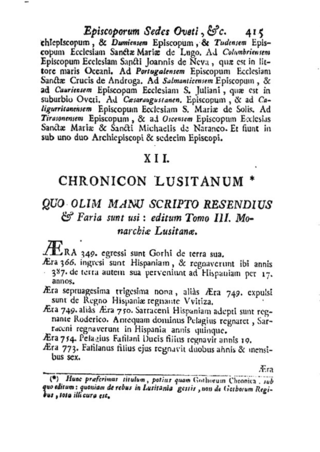
The Chronicon Lusitanum or Lusitano is a chronicle of the history of Portugal from the earliest migrations of the Visigoths through the reign of Portugal's first king, Afonso Henriques (1139–85). The entries in the chronicle, ordered by year and dated by the Spanish Era, get increasingly longer and the majority of the text deals with the reign of Afonso. The conventional title of the chronicle means "Lusitanian chronicle" or "chronicle of the Goths". It was first given by the editor Enrique Flórez, who rejected the title under which it had previously been edited because of its subject matter. Flórez also claims that the manuscript of the Chronicon had previously been utilised by André de Resende, the first archaeologist of Portugal, and Manuel Severim de Faria, the first journalist of Portugal; it was also edited in the third volume of the Monarchia Lusitana by António Brandão (1632).
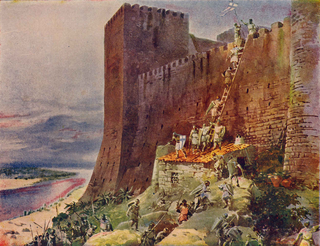
The conquest of Santarém took place on 15 March 1147, when the troops of the Kingdom of Portugal under the leadership of Afonso I of Portugal captured the Taifa of Badajoz city of Santarém.

De expugnatione Lyxbonensi is an eyewitness account of the Siege of Lisbon at the start of the Second Crusade, and covers the expedition from the departure of the English contingent on 23 May 1147 until the fall of Lisbon on 28 June 1148. It was written in Latin by one Raol, an Anglo-Fleming and probably a chaplain of Hervey de Glanvill in the army from East Anglia. It is an important source for the organisation of the crusade, especially among the middle ranks of society. An English translation by Charles Wendell David appeared in 1936 and was reprinted in 2001.
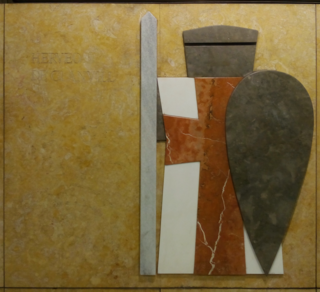
Hervey de Glanvill [Glanville] was an Anglo-Norman nobleman and military leader. He was a scion of a younger line of the Glanvill family, which had been established in East Anglia, especially Suffolk, since before 1086. He had several sons and daughters, the most prominent of which was Ranulf de Glanvill, who became justiciar of England.
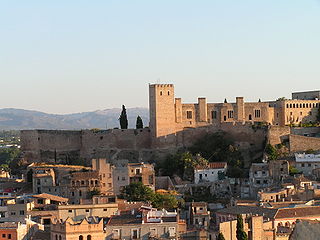
The siege of Tortosa was a military action of the Second Crusade (1147–49) in Spain. A multinational force under the command of Count Raymond Berengar IV of Barcelona besieged the city of Tortosa, then a part of the Almoravid Emirate, for six months before the garrison surrendered.
De itinere Frisonum is an eyewitness account written in Latin of the Frisian crusaders' journey from Friesland to Acre during the Fifth Crusade (1217–1218). The narrative was composed by an anonymous participant of the venture who most likely was a member of the clergy. Abbot Emo of Friesland of the Premonstratensian monastery of Bloemhof copied it without alterations into his chronicle. Emo's version is the only surviving copy of the lost original and it is kept in the Library of the University of Groningen in the Netherlands. The narrative is noteworthy for its detailed description of the geography of the lands encountered by the Frisian Crusaders on their journey and the author's perspective on the motivations of his compatriots during the venture. The narrative runs parallel up to the Frisian fleet's arrival to Lisbon with the Rhenish text known as Gesta crucigerorum Rhenanorum.

De expugnatione Scalabis is an anonymous Latin account of the Portuguese conquest of Santarém on 15 March 1147. It is the earliest and most detailed source for that event and is informed by eyewitness accounts.

The siege of Silves was an action of the Third Crusade and the Portuguese Reconquista in 1189. The city of Silves in the Almohad Caliphate was besieged from 21 July until 3 September by the forces of Portugal and a group of crusaders from northern Europe on their way to the siege of Acre. The defenders capitulated on terms, the city was handed over to Portugal and the crusaders took a portion of the spoils.

The siege of Alcácer do Sal lasted from 30 July to 18 October 1217. The well fortified city of Alcácer do Sal was a frontier outpost of the Almohad Caliphate facing Portugal. It was besieged by forces from Portugal, León, the military orders and the Fifth Crusade. The latter were led by Count William I of Holland. The expedition was the brainchild of Bishop Soeiro II of Lisbon, whose diocese was threatened by regular raids from Alcácer. King Afonso II of Portugal did not take part in person, but the city was incorporated into his kingdom after its capitulation. The crusaders who took part in the siege, mainly from the Rhineland and the Low Countries, did so without papal authorization and were afterwards ordered to continue on to the Holy Land.

The Carmen de expugnatione Salaciae is a Latin epic poem in 115 elegiac couplets describing the siege of Alcácer do Sal in 1217. It was written by Goswin of Bossut for Soeiro Viegas, bishop of Lisbon.

Portuguese participation in the Reconquista occurred from when the County of Portugal was founded in 868 and continued for 381 years until the last cities still in Muslim control in the Algarve were captured in 1249. Portugal was created during this prolonged process and largely owes its geographic form to it.

The mythical battle of Sacavém was a military clash between the first Portuguese king, Afonso Henriques, and the Moors from the taifa of Badajoz, at the beginning of the siege of Lisbon, that took place in early July 1147, on the shores of the Trancão River, near the old Roman bridge that, according to several ancient sources, crossed the river in the town of Sacavém, at the time know as Šaqabān.













